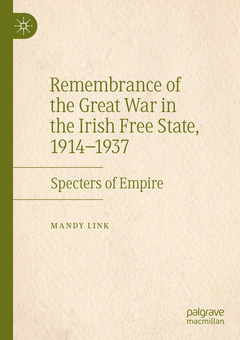Description
Remembrance of the Great War in the Irish Free State, 1914-1937, 1st ed. 2019
Specters of Empire
Author: Link Mandy
Language: English
Approximative price 84.39 €
In Print (Delivery period: 15 days).
Add to cartPublication date: 08-2020
Support: Print on demand
Approximative price 84.39 €
In Print (Delivery period: 15 days).
Add to cartPublication date: 06-2019
Support: Print on demand
Description
/li>Contents
/li>Biography
/li>Comment
/li>
This book focuses on how Irish remembrance of the First World War impacted the emerging Irish identity in the postcolonial Irish Free State. While all combatants of the ?war to end all wars? commemorated the war, Irish memorial efforts were fraught with debate over Irish identity and politics that frequently resulted in violence against commemorators and World War I veterans. The book examines the Flanders poppy, the Victory and Armistice Day parades, the National War Memorial, church memorials, and private remembrances. Highlighting the links between war, memory, empire and decolonization, it ultimately argues that the Great War, its commemorations, and veterans retained political potency between 1914 and 1937 and were a powerful part of early Free State life.
Highlights the connections between war, memory, empire and decolonization in early Free State Ireland
Explores the private acts of remembrance of Irishmen who served in the British Army during the First World War against the changing political landscape of revolutionary and independent Ireland
Argues that the Great War was a far more integral and powerful part of Irish national identity in the early twentieth century than has previously been asserted
These books may interest you

Remembering the First World War 46.39 €

Remembering the First World War 160.25 €


